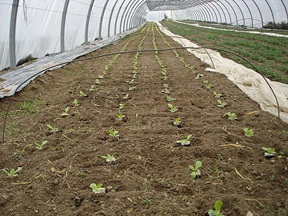A series of articles at the occasion of the GreenTech exhibition in Amsterdam, highlighted innovation in horticulture. Among these are water quality and irrigation management.

The site Greentech.nl pays special attention to innovation in horticulture. Among the new techniques is water use and treatment in an article by Jacco Strating. Water is an essential element in greenhouse horticulture. But it is not always available in unlimited quantities and qualities. Discharge of water is often environmentally restricted. Therefore, water recirculation is being developed quickly.
Water reuse
Reused water should be of good quality: clean, and containing sufficient oxygen to grow quality crops. Better quality will lead to better nutrient uptake. It will also produce a better and tastier product. Water should contain enough of what the plant needs, and as little as possible of other substances.
An innovation in horticulture is that water is being recirculated. This avoids needless waste of nutrients and water. Still, we should not recirculate unwanted micro-organisms. One of the techniques available is ultrafiltration. Here, separation takes place by leading the water through a semipermeable membrane, under pressure. This will remove suspended solids, while water and low molecular weight solutes pass through the membrane in the filtrate. UV and ozone treatments are also available, but these are more expensive in the long run; moreover, they may not provide the same level of assurance in maintaining water purity.

Greenhouse efficiency improved a lot
Innovation in horticulture is still developing. In the near future, we may achieve zero liquids discharge. This will entail the removal and reuse of nutrients like nitrate and phosphate from the water. But there is still much to know about plants. At Van den Ende company, they estimate that cultivation can still be optimized with 15 to 20 percent.
In the course of two decades, greenhouse efficiency has already improved a lot. Energy input has decreased by almost half. And so has water use. The energy crisis in the late 2000s triggered a major research effort. Modern greenhouses use climate screens on a daily basis. Sodium lamps have been replaced by low energy LED lighting. This has not been to the detriment of crop uniformity and yield quantity.
Innovation in horticulture: CO2 supply
An article by Rachel Anderson shows the development towards innovation in horticulture. Innovations as they were discussed at the GreenTech’s Research Meets Innovator networking event on June 12. ‘Trialling, testing, and information sharing are at the heart of successful innovation.’ For instance, Skytree develops and manufactures decentralized direct air capture (D-DAC) machines; they deliver onsite CO2 from ambient air. This stimulates plant growth. It enables indoor/vertical farms and greenhouses to secure a stable, sustainable (fossil-fuel free) supply of CO2 and reduce costs. Improvement is stunning. In 2022, the prototype machine produced one kilogram of CO2 per day; this year (2024) tests deliver as much as 1000 kg per day.
Then, Bogaerts Greenhouse Logistics developed a machine that performs UV-C treatment on crops as an innovation in horticulture. They successfully developed a light recipe that prevents mildew from spawning on strawberries. Helpfully, this reduces the need for chemicals to be applied to this crop.
Hazing the light
VitalFluid creates ‘lightning in a box’ by using air, water, and electricity. With it, they create plasma-activated water (PAW). This has temporary disinfecting properties. When the PAW is sprayed onto crops, it can help get rid of all kinds of pathogens, including mildew. It can serve both as a pre-harvest and as a post-harvest treatment. Leading to pathogen-free seeds and products. Together with UV-C, this is an effective alternative to chemicals to treat powdery mildew.
And then, a new lighting technique may increase plant density in greenhouses. The company MechaTronix developed a technique that hazes the light, making it to penetrate hard-to-reach parts of plants. This hazing technique increases plant density and productivity by at least 30 percent. With this innovation, vertical farming can become a more viable business; whereas now it is troubled by high capital and operating costs. All in all, innovation in horticulture hasn’t yet come to an end.
Interesting? Then also read:
Precision horticulture: what the consumer wants
Perspectives for agriculture – the new farming
Indoor farming: good and affordable vegetables for cities
